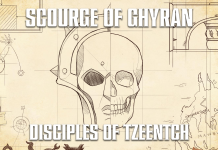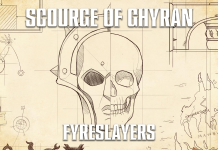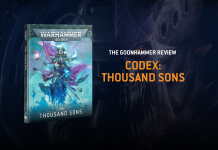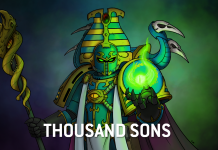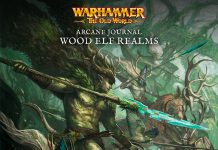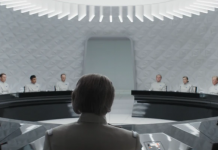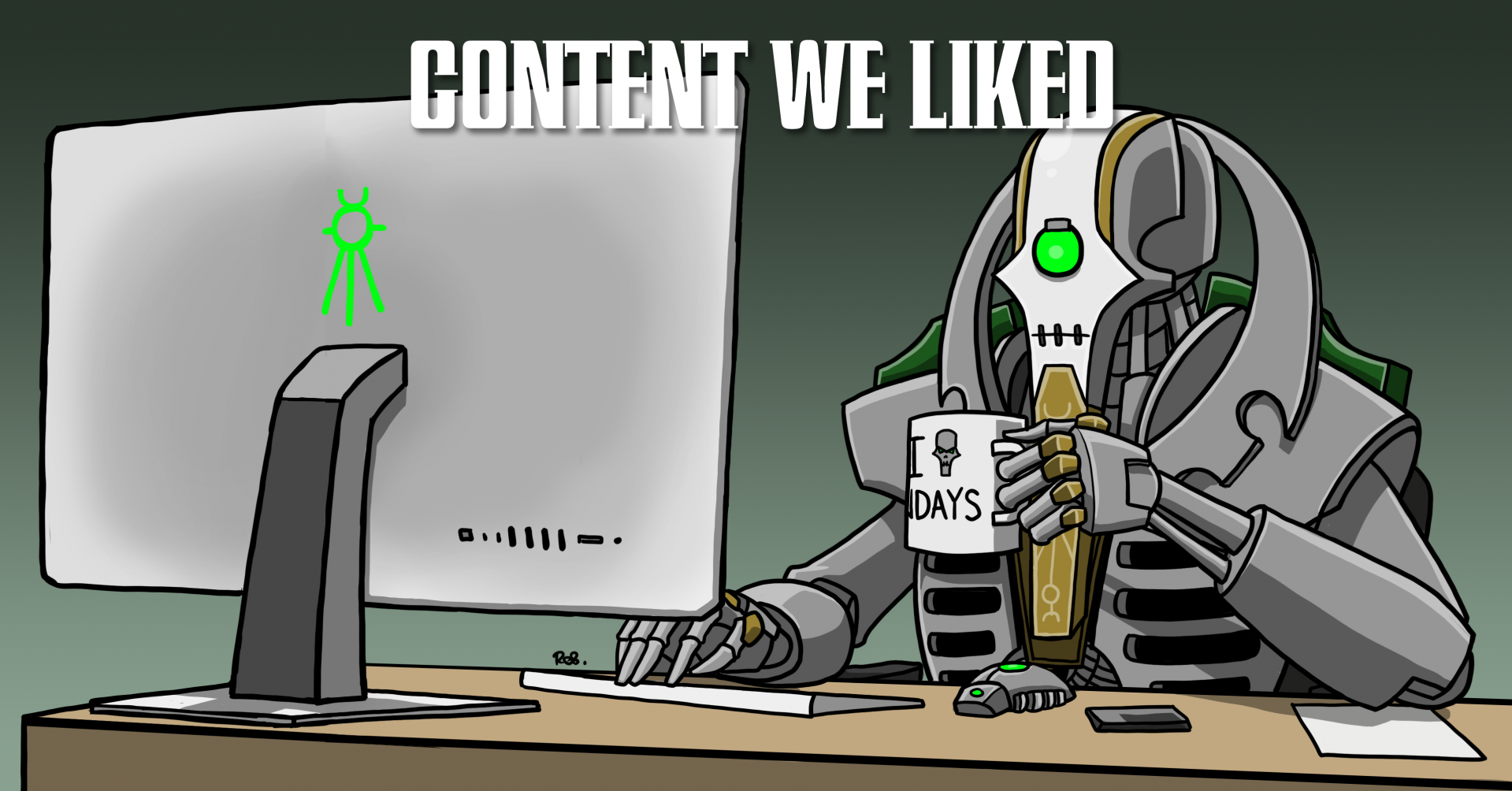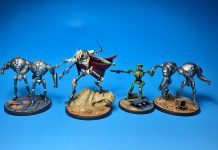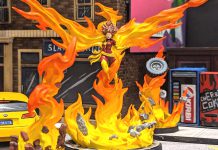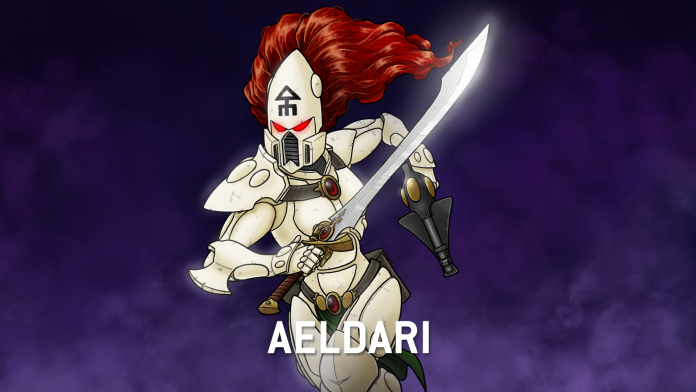Aeldari players finally have to think a little bit about how to approach their army instead of just slamming in 2 Wraithknights and shrugging as the sheer power of Fate dice and Devastating Wounds carry them to free wins. James “Boon” Kelling takes a look at his favourite faction and how it’s shaping up in a post-Balance Dataslate world.
The Aeldari (or Eldar, if you’re old) are in many ways the stereotype of fantasy elves but in space. They owe a large portion of their identity, including their common name, to the influence of Tolkien whose translation of Eldar, a division of elves, literally meant “people of the stars.” The physiological characteristics of Eldar in Warhammer remain largely congruous with the elves of Tolkien as does the broad strokes of their narrative arc as a species; they were created by a more powerful deity or pantheon of god-like beings, and the central aspect of their history is the way that a great enemy and sundering would unfold before leaving a once ascendant race in a dwindling but still potent state into the modern age. But it’s the specifics of the Eldar in Warhammer 40,000 that sets them apart and creates a rich lore unto its own, with a faction that is in many ways directly or indirectly connected to the origins of every other faction in the Warhammer universe with the notable exception of the Hive Mind. The Eldar are a race that are both tragic and haunted, possessed of a depth of awareness and terrible knowledge that fully separates them from the shorter-lived and less experienced races of the galaxy.
Why Should You Play Aeldari?
As a faction, Eldar offers a rich array of options and a playstyle that can be both frustrating for new players but highly rewarding when mastered. At their heart, the Eldar are a finesse army – relying on the combination of speed and diverse units and abilities to bring devastating amounts of damage to an opponent at the right time in the right place. Alternatively, leveraging those same concepts to avoid taking grievous damage themselves and ensuring that they lose only what is necessary to achieve their objective.
In the past the feel of the army has varied considerably, with 9th edition perhaps being the gold standard for balancing the feel of speedy, hard-hitting Aspect Warrior specialists, implacable Wraith constructs, and steadfast Guardian support elements in a way not seen since 3rd or 4th edition. In 10th, the elusive Harlequin elements of the race have been folded back into the singular index set as they have in editions past, rather than being a faction of their own. The resultant index is an incredibly deep and wide series of army options that, while much reduced in outright power over the initial launch, remains an extremely potent army on the table. As compared to past editions, the index remains an incomplete work in terms of internal balancing between the various elements; however, the fundamentals are strong and the future looks bright for the Eldar.
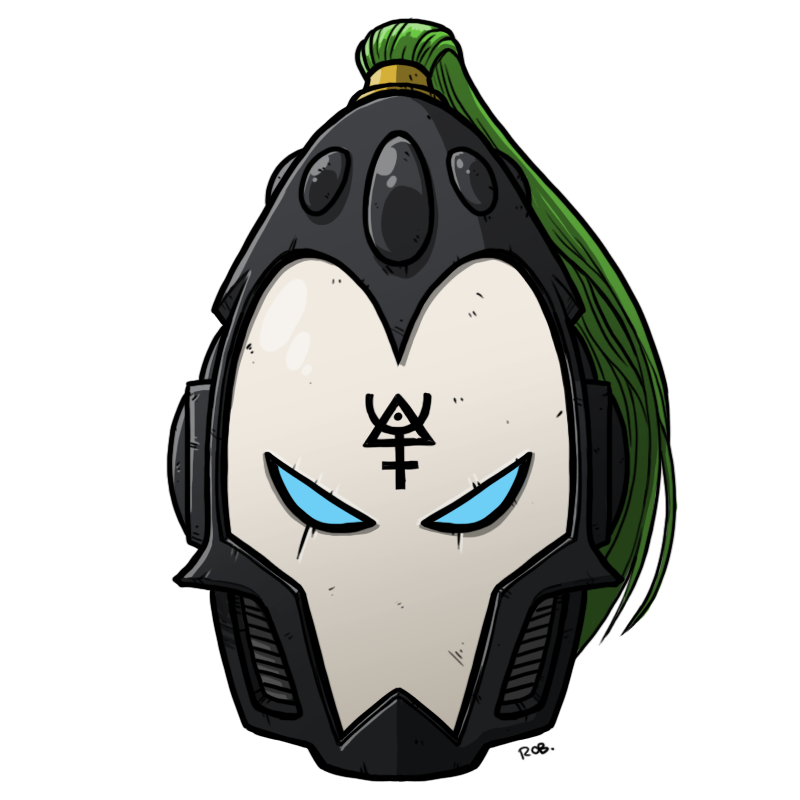
Five Things You Need to Know
- Fate Dice are Incredible. Fate dice, and in many ways the index detachment, serve one purpose – reducing chance and variability. The Eldar are a race of prescient know-it-alls who commit their resources when they know they should. This plays out on the table using Fate dice and leaving the odds of success not up to chance but to careful planning and consideration.
- You Are Fast. A hallmark of Eldar is their swift/fleet nature. Except for the Wraiths, the infantry, monsters, and vehicles all tend to be fast, mobile units that can speed around or converge on the table in support of an objective or one another.
- You Have Access to the Best Stratagem in the Game. To build on this speedy nature, Eldar have multiple stratagems that facilitate movement or movement-based bonuses. Chief among these is Phantasm which enables an infantry unit to make a Normal Move at the end of the opponent’s Movement phase, with full knowledge of the opponent’s position. It’s as if you know the future and it is exceptionally powerful.
- You Have Incredibly Potent Shooting. A hallmark of Eldar over the ages is their advanced and incredibly potent weaponry. The Distort-weaponry largely carried by Wraith constructs stands out here front and center, but Eldar do not lack for high strength, high armor penetration, and high damage weaponry across their order of battle.
- You Are Paper Thin. Again, except for Wraith constructs, your units are near universally at the lower end of the spectrum for toughness, wounds, and armor compared to other faction’s equivalent units. You will have lower model counts on average, and many of your heroes that are not an Avatar or Lone Operative will be constantly one bad turn away from oblivion owing to their low model count/low durability bodyguard. If you find yourself pinned in the open it’s not unreasonable to expect a large amount of your army will evaporate.
What Are the Must-Have Units to Start This Faction?
For our purposes, with a beginner mindset, I will limit must-have units to the generally available options and leave Forge World mostly out of this consideration, with one exception. However, units like the Hornet, Lynx, or the Wraithseer are all cool and/or interesting options either thematically or on the table that I may discuss in passing but will not focus on. I will however single out Shadow Spectres as they’re too common and too important to not discuss.
Avatars
There are two options here; the Avatar of Khaine, which is iconic and is a requisite to truly consider yourself an Aeldari player, and then the Yncarne, or the Avatar of Ynnead. Of the two the Yncarne is far more common to see in competitive lists, but both are very good and if you’re especially cool, both can be taken in the list for the first time ever in 10th edition. While the Avatar of Khaine is the tougher and the more punishing of the two, the Yncarne is more tricksy and can open opportunities not otherwise available in the army. Ultimately what you choose will depend on how you want your army to play and what you surround them with.
Farseer
Perhaps the second-most iconic unit in an Eldar army. The Farseers sit in an interesting spot in 10th edition as they have some powerful abilities but notable downsides. The Farseer on foot is capable of granting Fortune, a -1 to Wound buff, to any Aeldari unit within range (especially strong on durable platforms) while the Skyrunner variant is able to provide full hit re-rolls with Guide. Importantly, both Farseers can manipulate Fate dice to get the most out of your faction ability, turning one per turn into a 6 no matter the actual value of the dice. However, this comes with a trade-off in 10th edition. Farseers are not Lone Operatives and their bodyguard options are generally poor. Many successful competitive lists, particularly those out of the UK, take an individual Farseer on foot or on bike depending on the need – sometimes with the Phoenix Gem. Personally, I steer clear of anything that can be easily sniped out by indirect fire – and there is enough of it out there for me to be uncomfortable in taking this guy for now.
Autarch
This one is simple. There are three flavors of Autarch and currently only one of them is even close to viable. The Autarch Wayleaper. The key here is that as the Warlord he grants you an additional Command Point on your turn which becomes incredibly valuable for all the elf chicanery you want to pull.
Night Spinner
Some may see this entry and ask, “What about Fire Prisms?”. Fire Prisms are great, but they are a choice. Night Spinners on the other hand are a staple. Fortunately, for you they are the same kit and if you pick one up I highly recommend magnetizing it to swap one for the other over the years. However, if you are just starting out, a single Night Spinner is your first non-character pick. The reason for this is that it has a good indirect capability that provides reliable chip damage and can sometimes spike to deal considerable damage to just about any target. However, the true value of the Night Spinner is the ability of the gun itself which can slow an opponent’s movement and prevent an advance. The impact of this cannot be understated for an army that does not want to be rushed. The most hilarious application of this ability is to prevent the expensive but incredibly silly Transcendant C’Tan with a special enhancement from teleporting around the board and being both generally unkillable and unstoppable. You need one. Any more than that is a choice.
Swooping Hawks
An edition removed from their ultimate form. In 10th edition Swooping Hawks represent a very fast, very tough to pin down unit that can generally chip anything owing to their Lethal Hits and weight of fire, but primarily excel at being an objective grabbing unit that creates a lot of flexibility at a decent price. Being able to pick up and redeploy mid-game is a huge advantage for an army in reliably scoring secondaries that are challenging to plan for and may not be achievable due to positioning. One or two units of these are a staple for armies that want to fill up more expensive heavy-hitting options while still retaining some mission play.
Shadow Spectres
Sitting somewhere between Swooping Hawks and the next entry is the only Forge World unit I’ll feature in this list, Shadow Spectres. Like Swooping Hawks they are a flying infantry unit that can deep strike, but instead of being able to redeploy midgame they possess the ability to move up to 6″ after firing (note that as this is Shooting phase movement, it is not overwatchable). Movement is of course, king. However, they also possess two nice shooting profiles, the first an elite-mulching one shot at S6 AP-2 3D while the other is a d6 shots, blast, S4 AP-1 1D that makes them also very effective into hordes. As far as all-around flexibility goes, Shadow Spectres are hard to beat.
Warp Spiders
Significantly pricier than Swooping Hawks, Warp Spiders can fill a very similar role. However, they also provide a much wider series of capabilities owing to their high (though random) Torrent weapon output. Combining Torrent with Devastating Wounds means that Warp Spiders can chip anything in the game, and due to the nature of Torrent, are an excellent Overwatch platform that can then Phantasm away from danger. The combination of their high movement capability and meaningful, consistent output makes them an incredible all-around unit. That said, they are expensive and indirect platforms will almost assuredly target them out to limit your capabilities. Some competitive lists run two or three units, but for the cost and downside risk, I recommend starting with one.
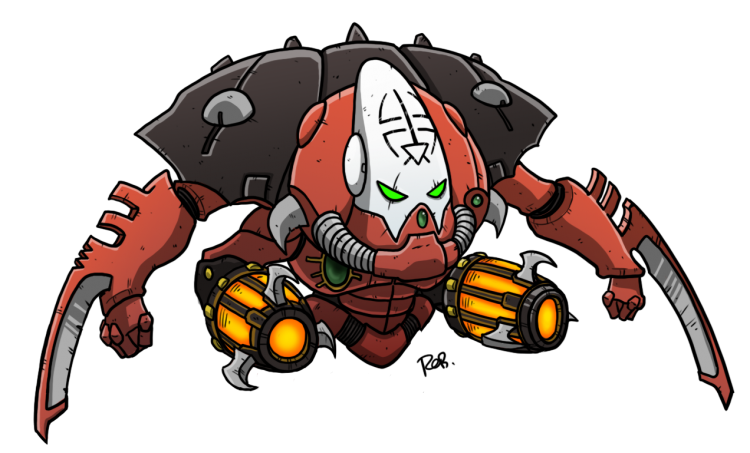
How Does This Faction Secure Objectives?
Aeldari are a mixed bag when it comes to objective scoring. Generally speaking, due to their army-wide mobility they excel at movement-based scoring, being in a certain location at a certain time. However, their units are also not very durable if forced into or caught out in the open which makes scoring surprisingly nuanced.
Primary
It’s hard to say anything definitively on scoring primary as the conditions can vary wildly from mission to mission. However, pinning Eldar to a fixed, predictable location can often be a death knell and so primary scoring represents a real risk. It is common to find that Eldar will play for later primary scoring by ceding some early points in turns one, two, or possibly even three, seeking to preserve the force and focus on whittling down certain elements of the opponent’s army, removing faster/utility units, and stretching them thin. Then in the later rounds using superior speed and firepower to outmaneuver the opponent or weather their reduced output to claim a larger share of primary points. Some units can stand and face the opponent’s full wrath. Wraith constructs and Avatars are capable of this, though be warned that these units will have a surprisingly thin Objective Control and it is rarely in your interest to game plan around this.
Secondary
Owing to their high mobility and tremendous firepower, Eldar tends to do very well on secondary objectives where it is rare that units are required to endure a full enemy turn before scoring. As a result, this is a real strength of the army without having to build specifically to it. Of course, units like Swooping Hawks, Shadow Spectres, Warp Spiders, and bikes of various types all excel in this type of role and will often exist in your army for this express purpose. Warp Spiders being able to commit a 24” move can solve a lot of positioning problems at almost any point in the game. A cheaper option are Swooping Hawks which can pick up at the end of the opponent’s turn and then redeploy out of deep strike in your following turn. The key here is understanding what you have in the army and what you need for different scenarios – in a pinch units like a Solitaire can fill in this role with a blitz move, temporarily forgoing it’s notional primary purpose of character/light infantry hunter in order to score points.
How Does This Faction Handle Enemy Hordes?
For a faction that notionally relies on very high quality, low quantity weapon profiles. Eldar are remarkably adept at handling hordes due in part to a bevy of dual-profile weapons where one half has Blast and also thanks to a lot of maneuverable, objective scoring units also maintaining double-duty as low/mid-strength, high volume shooting. Those very same units we talked about for secondary objective scoring are all excellent at horde clearance. Moreover, most Eldar staple vehicles, Night Spinners and Fire Prisms in particular, have powerful options to attack hordes. What’s also important is that Eldar are able to keep unwieldy hordes at arms-length using their speed.
That said, and this a near universal rule, Eldar will struggle when they are either pinned down or penned in – and horde armies, particularly those that have very fast-moving elements, can put Eldar on the back foot early and put them in a position where they are too buried to fight out and take board control late in the game. The danger from horde armies is that even a small number of low-attack, low-strength models are capable of inflicting serious damage on an Eldar army, which will degrade much more rapidly due to their low toughness/save and few numbers. Even the lowly Imperial Guardsmen is more than capable of punching out elf units in combat. You need to be killing what you hit before it can get in range to attack you.
How Does This Faction Handle Enemy Tanks and Monsters?
The army does not lack options for dealing with an enemy’s high armor, high toughness units. One of the unique quirks of the Eldar roster is that there are a lot of ‘platform’ options in which you then select a heavy weapon from the Eldar armory. In 10th it all starts, and usually ends, with the Bright Lance. Capable of being taken on a huge number of different units, it is an iconic weapon for absolutely burying heavily armored vehicles and monsters. Falcons, Vypers, Wraithlords, War Walkers, Wave Serpents, Crimson Hunters, and Guardians are all capable of bringing one. In addition to the Bright Lance, you have several powerful, purpose-built units like Fire Prisms, as well as various sizes of D-cannon or wraithcannon which are carried (predictably) by Wraithguard, Wraithseers, Wraithknights, and also by Support Weapon Platforms. Finally you have the Avatars – both the Yncarne and the Avatar of Khaine can deal with heavy armor and monsters without breaking a sweat. The question isn’t can you deal with enemy tanks and monsters, but rather what and how much do you need? The reality is that a lot of these options are going to be expensive and there will always be trade-offs in terms of what other capabilities these units can provide your army with and how you want it to function.
Where Eldar may struggle is that many of these platforms carrying high-powered capability will have a limited number of attacks. As I noted, these high-profile weapons are usually mounted on expensive units. Armies that can put a lot of invulnerable saves or just simply spike their invulnerable saves can create problems for you quickly if they are also able to reliably close with you and start to attrite your output – though between the Battle Host’s re-rolls and Fate dice, you have much more control over variance than other factions.
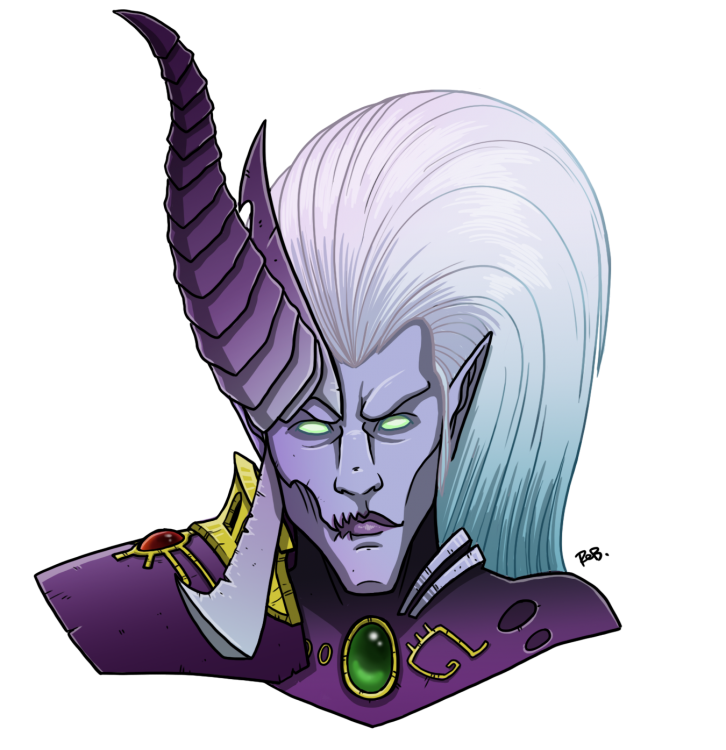
What Combos Should You Build Around?
Yncarne + Deep Threat
The first combo you want to be aware of is the Yncarne plus what I’ll call the “deep threat”. It’s not good enough to simply plan to take the Yncarne and prosper, you have to have an idea of how you want to use it. By that, I mean you need to have an idea of how you are going to leverage the Yncarne’s teleport to your advantage. Waiting for a unit to die by chance or misfortune is a losing mentality, you need to create that opportunity in an advantageous manner. You need a deep threat. Something that can reach back into your opponent’s lines and create opportunities for the Yncarne to wreck your opponent’s game plan.
The deep threat can be a wide number of units but they’ll each come with their own trade-offs. Fire Prisms and Night Spinners are common takes for this as they both have exceptionally long range. The former is just strong and likely to kill what it can see, while the latter doesn’t need to see to generate an opportunity. However, the trade offs on these should be obvious. The Fire Prism may not be able to generate line of sight, while the Night Spinner may not punch through enough damage to create that opportunity. Movement or leveraging additional platforms may mitigate for this but it can get expensive quick and will tend to form the core of your list and anchor it accordingly. However, these are not your only options, and indeed you should have more than one in your game plan. Fast or deep-striking infantry can be an exceptional deep threat if planned for appropriately. Certainly Warp Spiders and Swooping Hawks can fill this role but they tend to have large value outside of being a sacrificial lamb – still they can serve in a pinch. In my list, the Solitaire can help fill this role. In a lot of ways he is a fire-and-forget missile. Once he has his target, locks on and destroys. A combination of Fight First and Phantasm may keep him around and troublesome for an opponent’s backfield, but ultimately at T3 with just 3 wounds, he will go down. And that’s when the Yncarne can shine. When using an Yncarne it’s important to remember that just because you can do a thing does not mean you should. It is fully possible to overextend and put yourself in a bad position by being overeager.
Fate’s Messenger
An enhancement that has multiple uses throughout the roster but most prominently on the Spiritseer (as we’ll see in the next entry) or on my personal favorite unit, the Death Jester. The key to this enhancement is the option to roll the dice, see the results, then determine to flip to a 6 on any hit, wound, or save roll each turn. Defensively it can save a Fate dice or CP reroll, but offensively is where it shines as it can trigger offensive rules. It’s for this reason that I love taking it on a Death Jester who suddenly gains an absolute boatload of utility use with his ability for Sustained 3 + Devastating Wounds or sniping out a wounded character on his Precision + Devastating Wounds. Combined with the detachment reroll on hit and wounds it becomes an exceptionally dynamic tool and the Death Jester a problem-solving type of Lone Operative.
Spritseer + Wraith Constructs
After the Yncarne+, this is probably the most common combo out there right now. Somewhat obvious, the Spiritseer only has four options for units to join, but the Wraithguard with Wraithcannons are the clear standout owing to their powerful weaponry, unit ability to shoot back after being targeted, and high-damage guns with Devastating Wounds. It’s this latter piece that the aforementioned Fate’s Messenger enhancement comes into play – ensuring damage is dealt against a critical target in both players’ turns (assuming the unit is targeted and shoots back). This of course says nothing for the fact that Wraithguard themselves are an exceptionally durable unit, particularly for an Eldar army that otherwise lacks such a capability.
Yvraine + Drukhari
While Ynnari and Harlequins are now fully folded into the Aeldari index, bringing along Dark Eldar are still limited by strictly taking Yvraine and making her the Warlord. The trade-off here is significant as you lose access to the extra Command Point from an Autrach and Yvraine herself is not cheap and does not synergize well with her bodyguard options. The biggest reason for this is because she simply cannot ride in their respective transports (Raider, Venom, or Starweaver). Storm Guardians makes for an interesting landing spot from a defensive perspective due to the overlapping 5+ invulnerable and her 5+ Feel No Pain and unit resurrection… but it’s a bit expensive for not very much mobility or offensive output. So deep striking or riding in a Falcon is the common method for bringing her along and let her just kind of sort out her own messes.
However, for the cost you get access to a significant series of Drukhari options that greatly benefit from the Aeldari detachment ability. First among these are Ravagers, which when equipped are a potent and comparatively cheap source of Bright Lance equivalent Dark Lances that also carry the option to deep strike. Another similar option is Scourges, who can bring as many as four Dark Lances on a deep-striking shoot and move platform. Kabalites, Venoms, and Mandrakes can all fill some interesting roles within the Aeldari list as relatively cheap equivalents to their Craftworld cousins. As the meta changes with various releases, including an eventual Drukhari codex release, an eye should be kept on this space as it can create for some unique lists and combos.
Illic + Rangers
Lone Operative is a powerful thing, and while Illic does not himself possess the Lone Operative keyword, his datasheet abilities include a Lone Operative-like effect that can make himself, but also, a bodyguarding unit of Rangers effectively Lone Operatives. While an entire unit of high-upside Precison shooting can be useful, it’s the combination of Infiltrate and the Rangers datasheet ability that makes this a high utility unit. Notably, Rangers may move up to d6″ anytime an enemy unit comes within 9″ of them. Given the Lone Operative-like trait of Illic, this move ability, Phantasm, and their Infiltrate, they are a very challenging unit for an enemy to deal with and can provide you with a lot of options for scoring, screening, or board control from turn one onward.
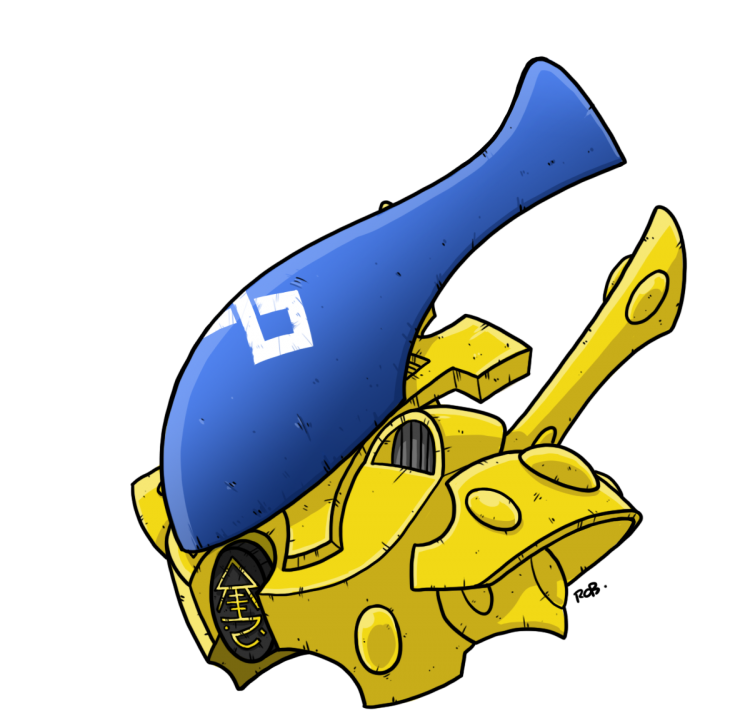
Army Lists
I offer two lists as examples of current competitive builds. The first list is my own double-Avatar list that I recently trotted out to the Goonhammer Open: Canada. The second is Hugo Richiardi’s list that he piloted to a second place at the London GT.
James “Boon” Kelling – 2nd Place – Goonhammer Open: Canada
James Kelling’s Aeldari - click to expand
For a full view on this list and its performance in competitive play, you can find the report here. The short version of this list is that it leverages the twin Avatars to anchor the army against any rapid press an opponent might give, while being exceptionally difficult to deal with in conjunction with Fate dice and use of the board to minimize angles. A bevy of exceptional damage dealing or utility characters are available to support in the objective game or to clip fast movers while a series of lower-priced but quality infantry provide the flexibility to score tactical secondaries.
Hugo Richiardi – 2nd Place – London Grand Tournament
Hugo Richiardi’s Aeldari - click to expand
No need to reinvent the wheel here as James “Wings” Grover has already done an excellent job summarizing in his weekly column, Competitive Innovations:
Taking a close second place, we have what was broadly the most popular top Aeldari strategy at the LGT, combining a brick of Wraithguard with lots of tools to force through scoring, usually a mix of fast Aspects, Lone Operatives and Fuegan, all backed up by Night Spinners. Wraithguard were easy to hide, stage and protect with Fire and Fade/Phantasm on the maps, which in combination with their durability made them very tricky to handle. That acts as an extremely solid core for these lists, and the use of Night Spinners to slow down the opponent’s most precious units combines with the army’s incredibly dense scoring capabilities and the headaches the Yncarne can cause to reliably push through victory after victory.
The only real solution is to have access to stuff that can body them quickly in melee, which is part of why launching Chosen from Rhinos is so strong in the metagame, but against most other forces the plan is tough to stop. Despite that, Hugo did successfully fight his way past several other armies with real answers to this on the way to the final, so congratulations on taking the runner up spot.
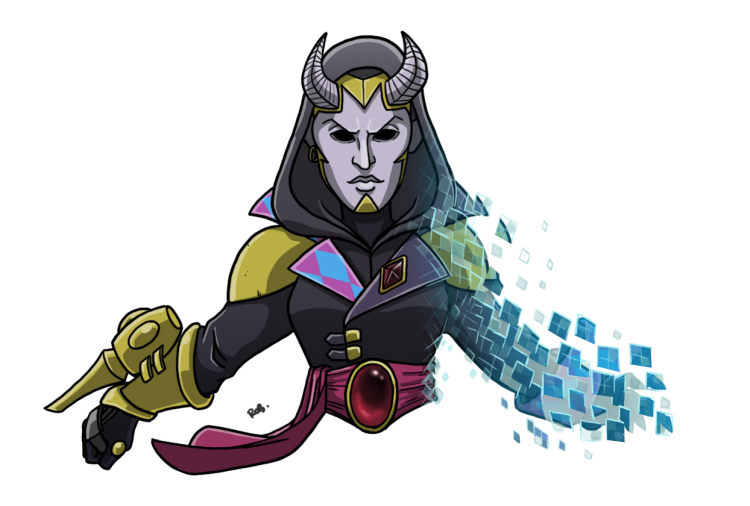
Wrap Up
I’ll look forward to updating this article as future data slates or other major meta changes occur and an eventual codex hits the street. In the meantime get out there and make your local “that guy” upset that elves continue to exist!
Have any questions or feedback? Drop us a note in the comments below or email us at contact@goonhammer.com.

